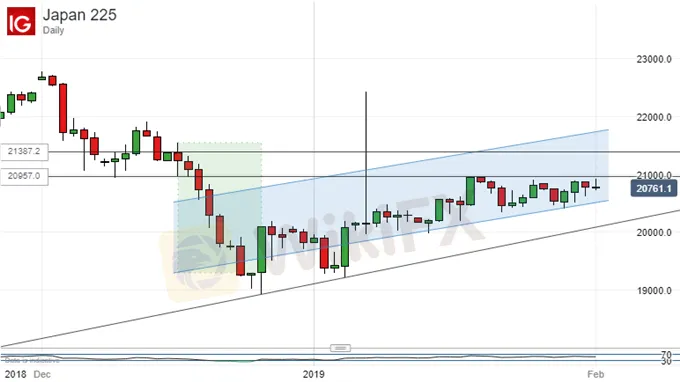简体中文
繁體中文
English
Pусский
日本語
ภาษาไทย
Tiếng Việt
Bahasa Indonesia
Español
हिन्दी
Filippiiniläinen
Français
Deutsch
Português
Türkçe
한국어
العربية
Asian Stocks Mixed On Trade Hopes, Weak China Data. Payrolls Eyed
Abstract:Local equity faced opposing forces as the week bowed out, with hopes for a US/China trade settlement pulling on way, and woeful Chinese manufacturing data
Asian Stocks Talking Points:
Bourses were mixed with moves mostly small Friday
Another set of Chinese manufacturing numbers severely underwhelmed
US labor statistics may provide the next directional cue
Find out what retail foreign exchange investors make of your favorite currencys chances right now at the DailyFX Sentiment Page
Hopes for a trade settlement between China and the United States gave some Asia Pacific equity markets a degree of support Friday, despite some terrible manufacturing numbers out of China which underlined once again how important a deal now is.
Investors also looked toward key US employment date due for release later in the session. Januarys nonfarm payrolls data are coming up after Asian bourses close with market expectations centered around a rise of 165,000 jobs and an unchanged unemployment rate of 3.9%.
US President Donald Trump told reporters on Thursday that he was hopeful for a deal with China before the March deadline. CNBC cited two sources in its story which claimed that Trump and his counterpart Chinese President Xi Jinping could meet in late February.
Countering this more hopeful looking scenario was the January Caixin Purchasing Managers Index survey of Chinas manufacturing sector. It registered the steepest contraction since 2016, hard on the heels of an official snapshot which, although slightly better than expected, was still very weak.
The Nikkei 225 was flat as its close approached, with the Kospi up by 0.1% and the Shanghai in the green by 0.5%. The Hang Seng was off by 0.4% with as the ASX200 down by 0.2%.
The Nikkei remains in the uptrend dominant since late December on its daily charts.
However, resistance formed by the top of steep falls which began earlier this month is still a tough nut for bulls to crack, and they have been trying for a little while now.

In the foreign exchange space, the Australian Dollar was hit by those Chinese numbers, while the Japanese Yen steadied. Overall risk appetite held up fairly well though. The US Dollar index tracks the currency against its major traded peers and was steady on the day.
Crude oil prices rose but remain caught between the competing impulses of trade hopes and clear signs of a Chinese slowdown. Gold prices look set to end the week on a high note, buoyed up by this weeks dovish Federal Reserve policy statement. The prospect of more cautious rate rises ahead offers relief to non-yielding assets such as gold by reducing the risk-free returns on US Treasuries.
Those US labor stats aside there are still plenty of economic data points to attract investor attention on Friday. The Eurozone‘s Consumer Price Index is due as are various Purchasing Managers Indexes for manufacturing sectors in Europe and Canada and the US. The Institute for Supply Management’s US snapshot is also coming up, along with constructions pending levels and the University of Michigans consumer sentiment index.
Disclaimer:
The views in this article only represent the author's personal views, and do not constitute investment advice on this platform. This platform does not guarantee the accuracy, completeness and timeliness of the information in the article, and will not be liable for any loss caused by the use of or reliance on the information in the article.
Read more

Saxo Enables Trading with 9 Crypto-FX Trading Pair on TradingView
The broker generated a turnover of $2.5 billion from crypto trading till last month.

Swiss Franc Price Outlook: USD/CHF Rally Grinds into Trend Resistance
The Swiss Franc may find its footing here as price reverses off near-term trend resistance. These are targets and invalidations levels that matter on the USD/CHF charts.

Australian Dollar Price Chart: AUD/USD Reversal Stalls– Trade Outlook
The Australian Dollar is up more than 2.6% on the back of a five-day rally with price eyeing initial resistance. These are the levels that matter on the AUD/USD charts.

Stocks Mixed As RBA Leaves Rates Alone, Australian Data Mixed Too
Equities were mostly lower, if not by very much. Australian interest rates remained at record lows. That was as expected, but retail sales disappointed as the current account surged ahead
WikiFX Broker
Latest News
How Sentiment Analysis Powers Winning Forex Trades in 2024
Capital One Faces Potential CFPB Action Over Savings Account Disclosures
Malaysian Woman's RM80,000 Investment Dream Turns into a Nightmare
Social Media Investment Scam Wipes Out RM450k Savings
FP Markets Received Three Major Awards
One article to understand the policy differences between Trump and Harris
M2FXMarkets Review 2024: Read Before You Trade
FX SmartBull Review! Read first, then Invest
Bangladesh steps up payments to Adani Power to avoid supply cut
Bitcoin.com Introduces Venmo for U.S. Bitcoin Purchases via MoonPay
Currency Calculator


